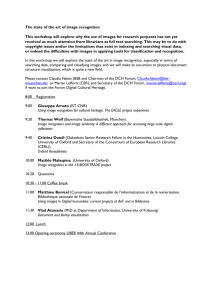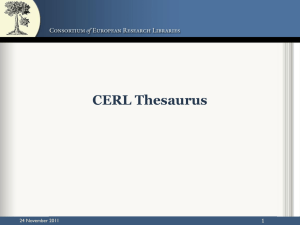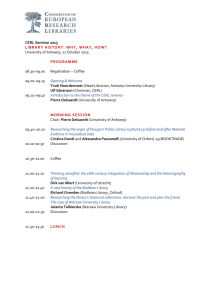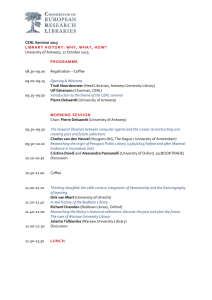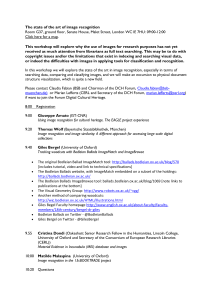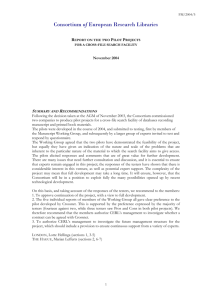FM 2004 9 CERL and EROMM Proposal
advertisement
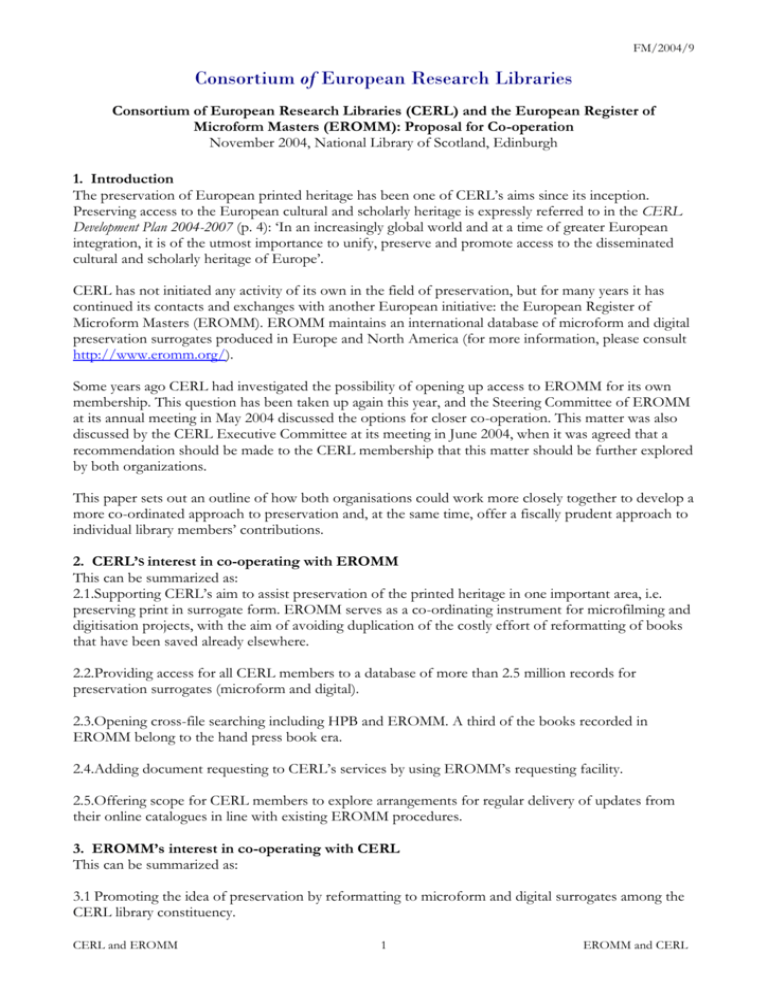
FM/2004/9 Consortium of European Research Libraries Consortium of European Research Libraries (CERL) and the European Register of Microform Masters (EROMM): Proposal for Co-operation November 2004, National Library of Scotland, Edinburgh 1. Introduction The preservation of European printed heritage has been one of CERL’s aims since its inception. Preserving access to the European cultural and scholarly heritage is expressly referred to in the CERL Development Plan 2004-2007 (p. 4): ‘In an increasingly global world and at a time of greater European integration, it is of the utmost importance to unify, preserve and promote access to the disseminated cultural and scholarly heritage of Europe’. CERL has not initiated any activity of its own in the field of preservation, but for many years it has continued its contacts and exchanges with another European initiative: the European Register of Microform Masters (EROMM). EROMM maintains an international database of microform and digital preservation surrogates produced in Europe and North America (for more information, please consult http://www.eromm.org/). Some years ago CERL had investigated the possibility of opening up access to EROMM for its own membership. This question has been taken up again this year, and the Steering Committee of EROMM at its annual meeting in May 2004 discussed the options for closer co-operation. This matter was also discussed by the CERL Executive Committee at its meeting in June 2004, when it was agreed that a recommendation should be made to the CERL membership that this matter should be further explored by both organizations. This paper sets out an outline of how both organisations could work more closely together to develop a more co-ordinated approach to preservation and, at the same time, offer a fiscally prudent approach to individual library members’ contributions. 2. CERL’S interest in co-operating with EROMM This can be summarized as: 2.1.Supporting CERL’s aim to assist preservation of the printed heritage in one important area, i.e. preserving print in surrogate form. EROMM serves as a co-ordinating instrument for microfilming and digitisation projects, with the aim of avoiding duplication of the costly effort of reformatting of books that have been saved already elsewhere. 2.2.Providing access for all CERL members to a database of more than 2.5 million records for preservation surrogates (microform and digital). 2.3.Opening cross-file searching including HPB and EROMM. A third of the books recorded in EROMM belong to the hand press book era. 2.4.Adding document requesting to CERL’s services by using EROMM’s requesting facility. 2.5.Offering scope for CERL members to explore arrangements for regular delivery of updates from their online catalogues in line with existing EROMM procedures. 3. EROMM’s interest in co-operating with CERL This can be summarized as: 3.1 Promoting the idea of preservation by reformatting to microform and digital surrogates among the CERL library constituency. CERL and EROMM 1 EROMM and CERL FM/2004/9 3.2 Keeping track of preserved publications beyond the limits of the present EROMM membership to broaden the basis currently offered for planning digitisation and microfilming projects. 3.3 Extending direct co-operation with libraries in European countries that have not yet joined EROMM. The aim is to include records for preservation surrogates provided by CERL members from these countries. 4. Common goals If there are to be closer links between CERL and EROMM, the EROMM Steering Committee has asked that CERL should support the following aims: 4.1 Promote the idea of preservation by reformatting to microform and digital surrogate. The current scope of EROMM should be maintained. This means that preservation surrogates of printed works shall continue to be recorded without limit in time or place of publication. 4.2 Keep track of preserved publications beyond the limits of the present EROMM membership to broaden the basis currently offered for planning digitisation and microfilming projects. CERL shall actively support the recording of preservation surrogates internationally both in its public statements and within its membership. This will include the continuation of the exchange of preservation surrogate records with other agencies (RLG, LAROMM), and the continuation of the provision of access to the EROMM database to all individuals and corporate bodies from member states. 4.3 Extend direct co-operation with libraries in European countries that have not yet co-operated with EROMM. This means a willingness to include records of preservation surrogates from all CERL members, while retaining the regular delivery of records by present EROMM members, and exploration of the possibility of establishing a basis for collecting records both for CERL and EROMM at the same time. 4.4 Continue EROMM’s requesting facility and extend copy requesting to include items not yet reformatted. Records from HPB should be used for requests just as records from the EROMM file. 5. Membership issues The members of EROMM and CERL overlap to a significant extent, as can be seen from the overview in the Appendix to this paper. The present rules for CERL membership are related to the use of HPB. Only members enjoy access to the HPB. Another important CERL product is the CT, which is available to the general public free of charge. EROMM does not restrict access to its database to its members. Instead EROMM members are regarded as representing their countries or regions: any library or individual residing there will automatically have the right to access the EROMM database. In a possible situation where both organisations were to join, the EROMM database would be added to the services offered by CERL. All countries, where at least one full member or a group member of CERL is located, would enjoy access to EROMM. The CERL members could be regarded sponsors of their national constituencies in respect of using EROMM. This is equivalent to the present role of EROMM Partners. In the case of individual libraries that wish (to continue) to work with CERL/EROMM as a national or regional node for EROMM, but do not wish to be involved in other CERL activities, it will be necessary to consider the definition of another form of membership. This ‘CERL-EROMM CERL and EROMM 2 EROMM and CERL FM/2004/9 membership’ would require an annual contribution similar or equal to the present subscription for EROMM (€1,968 p.a.); it would exclude access to the HPB. 6. CERL members contributing records Building a file of records for preservation surrogates is at the very centre of EROMM activity. Obviously the present EROMM membership regards it as an essential condition of any involvement with CERL that new countries which gain access to EROMM and will enjoy its services, will also contribute their records of preservation surrogates, or at least express a willingness to do so in the near future. CERL’s most valuable contribution would be to ask its members to take up the role of national or regional nodes, which would collect records from libraries in their area and make them available to EROMM. Libraries that contribute records to EROMM either directly or indirectly, are termed ‘EROMM Libraries’. Those having this status benefit from a few special services; these may include preferential treatment of their requests by other ‘EROMM libraries’. 7. Cross-file searching Searching of HPB and EROMM at the same time is an attractive option, since at least one third of the records in the EROMM file relate to books of the hand press period. The obvious technical choice for implementing this facility is Z39.50. It would be possible, however, to use a more refined technique, which would be adapted more specifically to both files and enable advanced search options. As long as access to the HPB remains limited to CERL members, simultaneous cross-file searching of HPB and EROMM is only capable of being undertaken by CERL members. 8. Requesting of copies and requesting of information EROMM has offered a requesting facility to subscribing members almost since its database went online. In recent years this facility has been developed further to allow the addition of detailed questions to a request, which is always related to a work recorded in the file. Although there are several hundred libraries contributing records, which are not members of EROMM themselves but are working through their nodes, it is possible to dispatch requests directly to them throughout Europe. Major American libraries can be contacted through this facility as well. In working together, requesting of copies could be extended to works that have not yet been reformatted. Using records found in the HPB but not recorded in EROMM, a request for copies could be sent to the library owning the original book. Thus user oriented reformatting could be organised in a more effective way. The same facility is open to be used for any kind of question the user may have in relation to a recorded work. Contact with any library is established with ease. 9. Financial issues There are several options to be considered. The present EROMM Partners contribute €1.968 annually to the EROMM budget. A second Partner in a single country makes the same contribution. 9.1.One model for providing a viable financial basis for co-operation could be that CERL contributes the same amount for every country added to the present 12 European countries working with EROMM. In this case those CERL members, who are also EROMM members, would be supporting this preservation activity both ways. CERL and EROMM 3 EROMM and CERL FM/2004/9 9.2 Another option could be realised through the merger of both organisations. In fact EROMM Partners would in this case contribute only via their subscription as CERL members. This would put them on the same footing as the other CERL members. 9.3 There may be other viable options to be considered. The overall cost of continuing to develop and maintain EROMM with its present host, Göttingen State and University Library (Niedersächsische Staats- und Universitätsbibliothek Göttingen), remains to be established. It is estimated to be not more than €50.000 p.a. ACTION: Based on the information in the present paper, and after full discussion at the Annual General Meeting in November 2004, CERL members are asked to come to a view on whether they wish to agree, in principle, that CERL should explore in detail further closer co-operation with EROMM, examining all aspects of the various options for collaboration including merger, and, keeping the membership appropriately informed throughout the year, should present the results to the Annual General Meeting for final decision in November 2005. Ann Matheson CERL Chairman Majlis Bremer-Laamanen EROMM President October 2004 CERL and EROMM 4 EROMM and CERL FM/2004/9 APPENDIX Membership by country for CERL (full members and associate members) and EROMM (full members) is set out below. CERL (a = associate) Belgium Croatia Czechia (a) Denmark Estonia (a) Finland France Germany Hungary Ireland (a) Italy Latvia (a) Lithuania Norway (a) Poland (a) Portugal Russia Slovakia (a) Spain Sweden Switzerland (a) Netherlands UK Ukraine (a) EROMM Austria Belgium Czechia Denmark Finland France Germany Portugal Sweden Switzerland Netherlands UK For the names of EROMM members go to http://www.eromm.org/erompa.htm. October 2004 CERL and EROMM 5 EROMM and CERL
